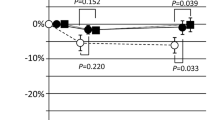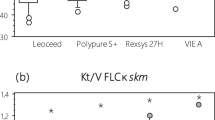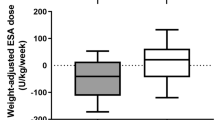Abstract
In the last years, the number of hemodialysis (HD) patients with erythropoietin (rHuEPO) resistance is increasing. Probably, central venous catheters (CVCs) contribute to this resistance by inducing inflammation and oxidative stress. This study was aimed to compare vitamin E-bonded dialyzer (PSVE) versus polyethersulfone membrane. Sixteen subjects with CVCs were included in a prospective two-arm crossover 12-month study. The primary endpoints were the rHuEPO requirement and the erythropoiesis-stimulating agents (ESA) index, which was defined by the ratio between weekly EPO dosage (IU/kg/week) and Hb levels (g/dl). The mean dosages of rHuEPO to maintain hemoglobin between 10.5 and 12 g/dl were 135 ± 59 and 101 ± 57 IU/kg/week with polysulfone and PSVE, respectively (P = 0.14). The ESA indexes were 12.1 ± 5.2 and 8.7 ± 5.2 (P < 0.0001) with polysulfone and PSVE, respectively. A trend towards consensual changes in protein glycoxidation, antioxidant, and inflammatory markers was observed. In conclusion, the study suggests a role for PSVE in the reduction of ESA index in HD patients with CVCs.



Similar content being viewed by others
References
Ethier J, Mendelssohn DC, Elder SJ et al (2008) Vascular access use and outcomes: an international perspective: results from the dialysis outcomes and practice patterns study. Nephrol Dial Transplant 23(10):3219–3226
Hung AM, Ikizler T (2008) Hemodialysis central venous catheters as a source of inflammation and its implications. Semin Dial 21(5):401–404
Wystrychowski G, Kitzler TM, Thijssen S et al (2009) Impact of switch of vascular access type on key clinical and laboratory parameters in chronic haemodialysis patients. Nephrol Dial Transplant 24(7):2194–2200
Chand DH, Teo BW, Fatica RA et al (2008) Influence of vascular access type on outcome measures in patients on maintenance hemodialysis. Nephron Clin Pract 108:112
Movilli E, Brunori G, Camerini C et al (2006) The kind of vascular access influences the baseline inflammatory status and epoetin response in chronic hemodialysis patients. Blood Purif 24(4):387–393
Locatelli F, Aljama P, Barany P et al (2004) Revisited European best practice guidelines for the management of anaemia in patients with chronic renal failure. Nephrol Dial Transplant 19(S2):ii32–ii36
De Francisco AL, Stenvinkel P, Vaulont S (2009) Inflammation and its impact on anaemia in chronic kidney disease: from haemoglobin variability to hyporesponsiveness. Nephrol Dial Transplant 2(S1):i18–i26
Zadeh KK, Lee G, Miller J (2009) Predictors of Hypo responsiveness to erythropoiesis-stimulating agents in haemodialysis patients. Am J Kidney Dis 53(5):823–834
Galli F (2002) Vitamin E-modified dialysers. Contrib Nephrol 137:95–105
Satoh M, Yamasaki Y, Nagake Y et al (2001) Oxidative stress is reduced by the long-term use of vitamin E-coated dialysis filters. Kidney Int 59(5):1943–1950
Morimoto H, Nakao K, Fukuoka K et al (2005) Long-term use of vitamin E-coated polysulfone membrane reduces oxidative stress markers in haemodialysis patients. Nephrol Dial Trasplant 20(12):2775–2782
Usberti M, Gerardi G, Micheli A et al (2002) Effects of erythropoietin and vitamin E-modified membrane on plasma oxidative stress markers and anemia of hemodialyzed patients. Am J Kidney Dis 40(3):590–599
Sasaki M (2006) Development of vitamin E-modified polysulfone membrane dialyzers. Int J Artif Organs 9(1):50–60
Floridi A, Piroddi M, Pilolli F et al (2009) Analysis method and characterization of the antioxidant capacity of vitamin E-interactive polysulfone hemodialyzers. Acta Biomater 5(8):2974–2982
Andrulli S, Di Filippo S, Manzoni C et al (2010) Effect of synthetic vitamin E-bonded membrane on responsiveness to erythropoiesis-stimulating agents in haemodialysis patients: a pilot study. Nephron Clin Pract 115:82–89
Matsumura M, Sasaki H, Sekizuka K et al (2010) Improved management of intradialytic hypotension (IDH) using vitamin E-bonded polysulfone membrane dialyzer. Int J Artif Organs 33(3):147–153
Daugirdas JT, Depner TA, Gotch FA et al (1997) Comparison of methods to predict equilibrated Kt/V in the HEMO pilot study. Kidney Int 52:1395–1405
Tattersall J, Martin-Malo A, Pedrini L et al (2007) EBPG guideline on dialysis strategies. Minimum adequate dialysis. Nephrol Dial Transplant 22(S22):ii5–ii21
Galli F, Benedetti S, Floridi A (2005) Glycoxidation and inflammatory markers in patients on treatment with PMMA-based protein-leaking dialyzers. Kidney Int 67:750–759
Floridi A, Trizza V, Paolotti P et al (1999) Analytical strategy for the assessment of the protein glycation status in uremic patients by high-performance liquid chromatography. J Chromatogr 846:65–71
Galli F (2007) Protein damage and inflammation in uraemia and dialysis patients. Nephrol Dial Transplant S5:20–36
Thornalley P, Rabbani N (2009) Highlights and hotspots of protein glycation in end-stage renal disease. Semin Dial 22:400–404
Piroddi M, Palazzetti I, Quintaliani G et al (2011) Circulating levels and dietary intake of the advanced glycation end-product marker carboxymethyl lysine in chronic kidney disease patients on conservative predialysis therapy: a pilot study. J Ren Nutr 21(4):329–339
Foley RN, Chen SC, Collins AJ (2009) Hemodialysis access at initiation in the US, 2005–2007: still “catheter first”. Hemodial Int 13:533–542
Kanbay M, Perazella MA, Kasapoglu B et al (2010) Erythropoiesis stimulatory agent- resistant anemia in dialysis patients: review of causes and management. Blood Purif 29(1):1–12
Usberti M, Gerardi G, Micheli A et al (2002) Effects of a vitamin E-bonded membrane and of glutathione on anemia and erythropoietin requirements in hemodialysis patients. J Nephrol 15(5):558–564
Locatelli F, Andrulli S, Memoli B et al (2006) Nutritional-inflammation status and resistance to erythropoietin therapy in haemodialysis patients. Nephrol Dial Transplant 21(4):991–998
Gaweda AE, Goldsmith LJ, Brier ME et al (2010) Iron, inflammation, dialysis adequacy, nutritional status, and hyperparathyroidism modify erythropoietic response. Clin J Am Soc Nephrol 5(4):576–581
Johnson DW, Pollock CA, Macdougall IC (2007) Erythropoiesis-stimulating agent hyporesponsiveness. Nephrology 12(4):321–330
Elliott J, Mishler D, Agarwal R (2009) Hyporesponsiveness to erythropoietin: causes and management. Adv Chronic Kidney Dis 16(2):94–100
Nakatan T, Takemoto Y, Tsuchida AK (2003) The effect of vitamin E-bonded dialyzer membrane on red blood cell survival in hemodialyzed patients. Artif Organs 27(3):214–217
Kobayashi S, Moriya H, Aso K et al (2003) Vitamin E-bonded hemodialyzer improves atherosclerosis associated with a rheological improvement of circulating red blood cells. Kidney Int 63(5):1881–1887
Cruz DN, De Cal M, Garzotto F (2008) Effect of vitamin E-coated dialysis membranes on anemia in patients with chronic kidney disease: an Italian multicenter study. Int J Artif Organs 31(6):545–552
Galli F (2010) On the antiatherogenic effects of vitamin E: the search for the holy grail. Vasc Health Risk Manag 6:69–71
Panichi V, Barattini M, Angelini D et al (2011) A vitamin E-coated polysulfone membrane reduces inflammatory markers and EPO requirement in haemodialysis patients. Blood Purif 32(1):7–14
Locatelli F, Covic A, Eckardt KU et al (2009) Anaemia management in patients with chronic kidney disease: a position statement by the anaemia working group of european renal best practice (ERBP). Nephrol Dial Transplant 24(2):348–354
Author information
Authors and Affiliations
Corresponding author
Rights and permissions
About this article
Cite this article
Mandolfo, S., Corradi, B., Bucci, R. et al. Evaluation of the impact of a new synthetic vitamin E-bonded membrane on anemia and rHuEPO requirement in ESRD patients with central venous catheters: a pilot study. Int Urol Nephrol 44, 1493–1500 (2012). https://doi.org/10.1007/s11255-011-0016-9
Received:
Accepted:
Published:
Issue Date:
DOI: https://doi.org/10.1007/s11255-011-0016-9




